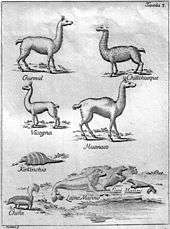Chilihueque

Chilihueque or Hueque is a South American camelid variety or species that existed in central and south-central Chile in Pre-Hispanic and colonial times. There are two main hypotheses on their status among South American camelids: the first one suggests that they are locally domesticated guanacos and the second that they are a variety of llamas brought from the north into south-central Chile.[1] The alpaca has also been suggested as a possible identity.[2]
According to Juan Ignacio Molina, the Dutch captain Joris van Spilbergen observed the use of chilihueques by native Mapuches of Mocha Island as plough animals in 1614.[3]
Chilihueques populations declined towards extinction in the 16th and 17th century, being replaced by European livestock.[1] The causes of its extinction are not clear[1] but it is known that the introduction of sheep caused some competition among both domestic species.[4] Anecdotal evidence of the mid-17th century show that both species coexisted but suggests that there were many more sheep than chilihueqes.[4] The decline of chilihueques reached a point in the late 18th century when only the Mapuche from Mariquina and Huequén next to Angol raised the animal.[4]
References
- 1 2 3 Bonacic, Cristián (1991). Características biológicas y productivas de los camélidos sudamericanos. Avances en ciencias veterinarias. Vol. 6, No. 2.
- ↑ Wilhelm, O.E. (1978). "The Pre-Columbian Araucanian Chicken (Gallus inauris)". Advances in Andean Archaeology. Mouton Publishers: 190. Retrieved 25 March 2018.
- ↑ The Geographical, Natural and Civil History of Chili, Pages 15 and 16, Volume II
- 1 2 3 Torrejón, Fernando; Cisternas, Marco; Araneda, Alberto (2004). "Efectos ambientales de la colonización española desde el río Maullín al archipiélago de Chiloé, sur de Chile" [Environmental effects of the spanish colonization from de Maullín river to the Chiloé archipelago, southern Chile]. Revista Chilena de Historia Natural (in Spanish). 77: 661–677.